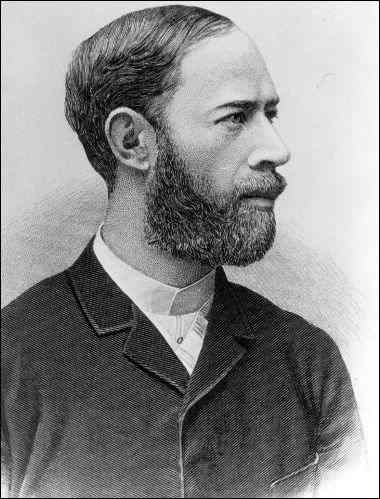

 |
|
|
Heinrich Rudolph HERTZ
1857 - 1894
As the 19th century drew to a close, a number of important discoveries in the field of physics were made. One of them - the discovery of electromagnetic radiation - was the achievement of Heinrich Hertz, a German physicist. Hertz's research paved the way for the development of radio, television, and radar. In recognition of his work, the unit of frequency of a radio wave, one cycle per second, is named the hertz.
Heinrich Rudolf Hertz was born in Hamburg, Germany, on Feb. 22, 1857. His father was a prominent lawyer and legislator. In his youth Heinrich enjoyed building instruments in the family workshop. Hertz began his college studies at the University of Munich. After a short time he transferred to the University of Berlin, where he received his Doctor of Philosophy degree magna cum laude in 1880, where he studied under Hermann von Helmholtz. And after that he was an assistant to Hermann von Helmholtz, one of the foremost physicists of the time.
In 1883 he began his studies of the electromagnetic theory of James Clerk Maxwell.
In 1883 Hertz became a lecturer in theoretical physics at the University of Kiel. Two years later he was appointed professor of physics at Karlsruhe Polytechnic. In 1886 Hertz married Elizabeth Doll, daughter of a Karlsruhe professor; they had two daughters. In the 1880s physicists were trying to obtain experimental evidence of electromagnetic waves. Their existence had been predicted in 1873 by the mathematical equations of James Clerk Maxwell, a British scientist.
In 1887 Hertz tested Maxwell's hypothesis. He used an oscillator made of polished brass knobs, each connected to an induction coil and separated by a tiny gap over which sparks could leap. Hertz reasoned that, if Maxwell's predictions were correct, electromagnetic waves would be transmitted during each series of sparks. To confirm this, Hertz made a simple receiver of looped wire. At the ends of the loop were small knobs separated by a tiny gap. The receiver was placed several yards from the oscillator.
In 1888, in a corner of his physics classroom at the Karlsruhe Polytechnic in Berlin, Hertz generated electric waves by means of the oscillatory discharge of a condenser through a loop provided with a spark gap, and then detecting them with a similar type of circuit. Hertz's condenser was a pair of metal rods, placed end to end with a small gap for a spark between them. When these rods were given charges of opposite signs, strong enough to spark, the current would oscillate back and forth across the gap and along the rods.
With this oscillator, Hertz solved two problems: (1) Timing Maxwell's waves (he had conclusively demonstrated, what Maxwell had only theorized: that the velocity of radio waves was equal to the velocity of light), and (2) How to make the electric and magnetic fields detach themselves from wires and go free as "Maxwell's waves".
Hertz's students were impressed, and wondered what use might be made of this marvelous phenomenon. But Hertz thought his discoveries were no more practical than Maxwell's.
"It's of no use whatsoever," he replied.
"This is just an experiment that proves Maestro Maxwell was right, we just have these mysterious electromagnetic waves that we cannot see with the naked eye. But they are there."
"So, what next?" asked one of his students at the University of Bonn.
Hertz shrugged. He was a modest man, of no pretensions and, apparently, little ambition.
"Nothing, I guess."
But, even at a theoretical level, Hertz's accomplishments were quickly seen by others as the beginning of a new "electric age." The English mathematical physicist, Sir. Oliver Heaviside, said in 1891,
"Three years ago, electromagnetic waves were nowhere. Shortly afterward, they were everywhere."
Summing up Hertz's importance: his experiments dealing with the reflection, refraction, polarization, interference and velocity of electric waves would trigger the invention, soon after, of the wireless telegraph and of radio.
It happened this way: in 1888, Hertz described in an electrical journal how he was able to trigger his electromagnetic waves with his oscillator. A young man in his teens happened to read the article while he was vacationing in the Alps. For him, Hertz's discovery gave him an idea: why not use the waves set off by Hertz's spark oscillator for signaling? Guglielmo Marconi was that young man. He rushed back home to Italy to give the idea a try.
Another of his discoveries was the photoelectric effect. In 1889 Hertz was appointed professor of physics at the University of Bonn.
When Hertz died in Bonn, Germany, on Jan. 1, 1894, Sir Oliver Lodge gave Hertz credit for accomplishing what the great English physicists of the time were unable to do. It was not hard to give Hertz credit. Not only had he established the validity of Maxwell's theorems, he had done so with a winning modesty.
"He was a noble man," said one eulogist in 1894, "who had the singular good fortune to find many admirers, but none to hate or envy him; those who came into personal contact with him were struck by his modesty and charmed by his amiability.
He was a true friend to his friends, a respected teacher to his students, who had begun to gather around him in large numbers, some of the coming from great distances; and to his family a loving husband and father."
According to theory, if electromagnetic waves were spreading from the oscillator sparks, they would induce a current in the loop that would send sparks across the gap. This occurred when Hertz turned on the oscillator, producing the first transmission and reception of electromagnetic waves. Hertz also noted that electrical conductors reflect the waves and that they can be focused by concave reflectors. He found that nonconductors allow most of the waves to pass through.
His scientific papers were translated into English and published in three volumes: Electric Waves (1893), Miscellaneous Papers (1896), and Principles of Mechanics (1899).